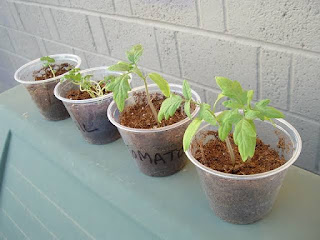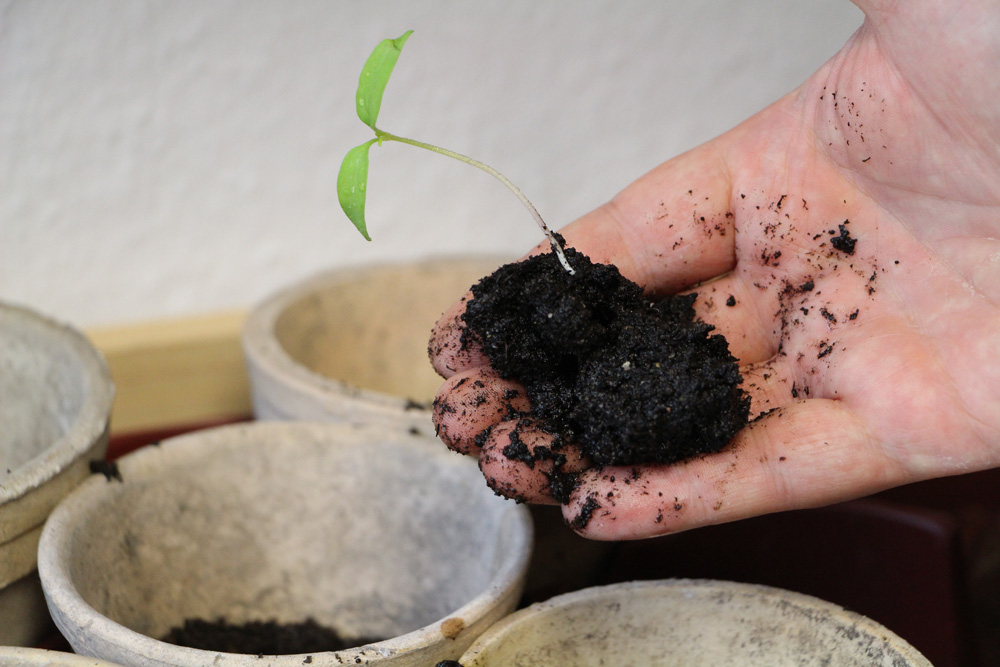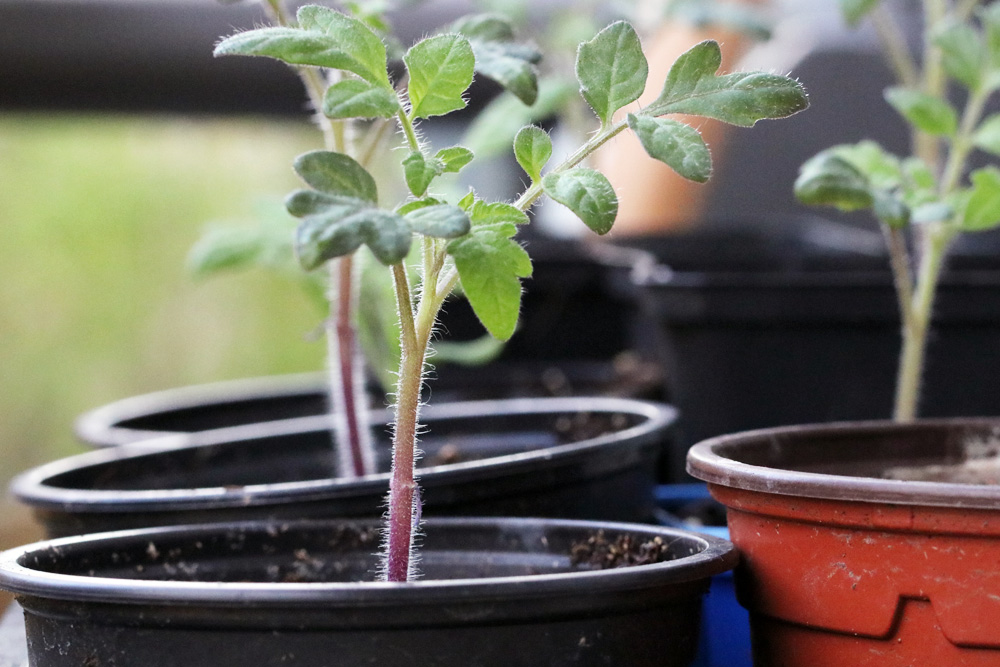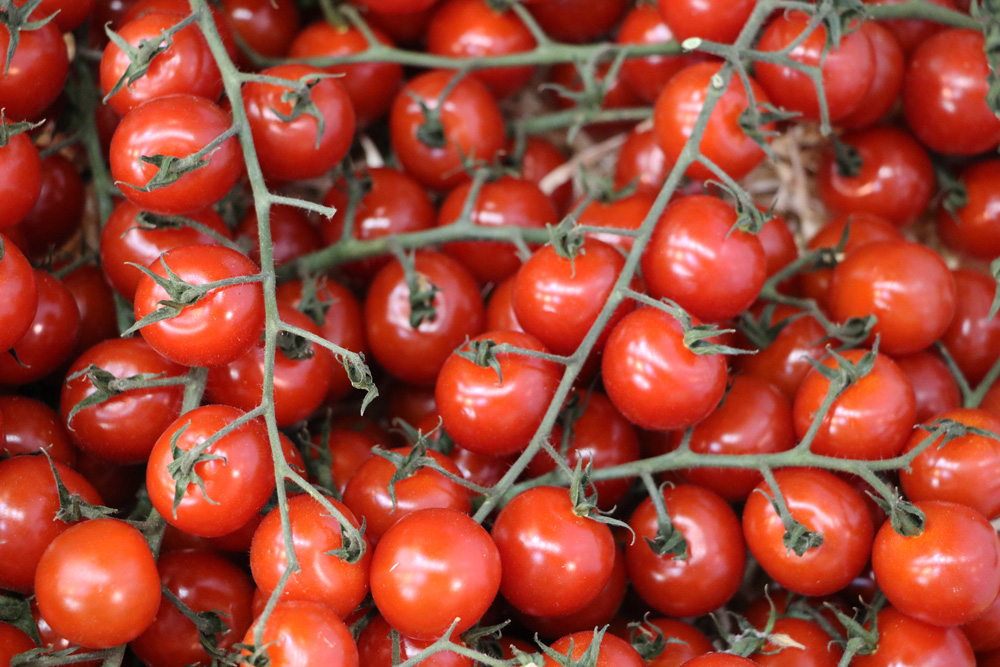Growing your tomatoes indoors is a task that is becoming more and more fashionable every day, since growing and planting tomatoes is a very rewarding gardening activity.
Tomato is one of the most popular vegetables among all gardening lovers to plant, it can be said that in 1 out of 3 orchards, it is common to have tomatoes planted.
If you look at a seed catalog, especially one of vegetables, you will soon realize that the selection of tomato transplants is a very important section within any nursery.
So if you don't have a garden, that doesn't mean you can't plant and grow your tomatoes indoors, growing them from seed and giving you a special opportunity to grow different varieties of tomato species.
Growing and growing tomatoes from seed is not difficult, but there are a few things to keep in mind.
As with all agricultural tasks, the season and genetics, as well as the environment, are important factors to take into account when planting your tomatoes.
What you may need to grow tomatoes indoors
To grow tomatoes indoors, you need specific growing conditions. However, there are certain items you can include to make indoor gardening easier to provide for these conditions.
To start, it is efficient to grow your tomatoes on a certain type of table or shelf, this makes it easier to care for them.
It also makes the task easier if you choose to use grow lights to grow your tomatoes indoors. Tomatoes need about eight hours of sunlight a day.
This can be difficult to achieve during the winter, especially if you don't have an extremely sunny spot in your home.
In this case, I recommend that you use grow lights, but you don't have to invest in the more expensive options. Use any type of bright lighting to care for your tomato plants.
I have used store lights, rather than traditional grow lights, when growing indoors. You may find LED light strips that can work too.
By now, it probably goes without saying, but you will need containers to grow. Large pots or 10-liter buckets will be sufficient for growing tomatoes indoors.
The key is to make sure the container they are planted in has good drainage. Having a suitable setup for growing tomatoes indoors will make the task much easier.
Growing conditions for indoor tomatoes
Indoor tomatoes have some specific needs that must be met in order for them to grow properly. To start with, tomatoes need sunlight.
If you have a sunny window that can provide your plants with eight or more hours of sunlight, this would be a great place to grow them.
However, if you don't have a sunny spot or your window can't provide the full eight hours of sunlight, it's a good idea to invest in grow lights.
You can grow your tomatoes under grow lights full time or use them to supplement your lighting. Once you've found the right place to grow tomatoes, it's time to consider how you should grow them.
Tomatoes are great for growing in pots. The pot should have large drainage holes. Clay pots are also recommended because they allow the plants to dry completely between watering sessions.
It is also wise to grow smaller tomato varieties when grown indoors. They seem to do better in these different circumstances.
By providing a suitable growing location, hopefully your tomato plants will thrive in your care.
Time and place of tomatoes indoors
Tomato seeds generally start indoors, either in a greenhouse or on a sunny ledge and then transplanted into beds when they have at least a couple of leaves and an established root system.
Not all seeds have to be planted indoors, tomato seeds need a constant soil temperature of at least 60 degrees and even 80 degrees in order to germinate.
Many times in temperate climates, the soil or soil does not reach this temperature in summer, so it will be too late for the tomatoes to grow and ripen before the end of the growing season.
Learn More
Indoor tomatoes growing methods
Choosing a soil mixture and in this case a quality organic soil, available in any nursery is the most effective means for your tomatoes to grow.
As for where you want to plant your tomatoes, it is more than evident that plastic pots are the most recommended option for the first days of growth.
3 significant step indoor tomatoes growing
1. Fill the pots with quality potting soil and place a couple of seeds on top near the center of the pot (placing a couple or three of seeds will ensure that if one of them does not bear fruit it may be the other seed).
2. Cover these seeds with a layer of soil and press the soil with your fingers since good contact of the seed with the soil is of vital importance for germination.
3. Sprinkle water over the seeds whenever the top of the soil mix looks dry, but don't water too much, as plenty of water could cause the seeds to rot.
The tomato plants inside your house need sun, so you will have to put them in a sunny window with at least 4 hours of direct sunlight a day or even a little more, the more temperature they receive, the better their germination will be.
Tip: You can cover your pots hermetically with plastic and take advantage of the greenhouse effect to heat the soil when the sun has risen and thus keep them warm at night.
Important: Anyway you have to be very careful with this advice, since if you cover these seeds to keep warm, you must remove this greenhouse cover as soon as they begin to germinate, otherwise they can succumb to diseases or fungal infections that usually proliferate in still, humid air.
Brown and gray spots may appear on the leaves followed by the death of the seedling.
2. Cover these seeds with a layer of soil and press the soil with your fingers since good contact of the seed with the soil is of vital importance for germination.
3. Sprinkle water over the seeds whenever the top of the soil mix looks dry, but don't water too much, as plenty of water could cause the seeds to rot.
Prefer tomatoes
For many hobby gardeners, the advantage of sowing their own seeds lies primarily in the choice of tomato seeds. Because this is far more diverse than the range of young plants that can be bought. If the tomato plants are cultivated permanently in the house, this also has the positive aspect that sowing can take place as early as January or February. When moving forward, it is important
Please note the following:
- Spread the seeds on a bowl with moist potting soil
- ideally at a distance of about 3 cm
- an egg carton filled with moist potting soil is also suitable
- Put a thin layer of soil on top
- ideally cover with a foil
- this ensures constant humidity
- however, this film must be removed daily
- so that a permanent exchange of air is possible
- then place the container on a sunny window ledge
- Always keep the soil moist, but not too wet
- Seeds germinate particularly quickly, at a temperature of 20-24 ° degrees
- the first leaves form after about 6-10 days
Prick and set for indoor tomatoes plant
When the first leaves appear, it is time to prick out the plants. The young plants are carefully removed from the ground and placed in their own containers. If the tomato plants are grown in the apartment, it is advisable to put the tomato plants in pots. An optimal pot is characterized by the following features:
- Pot size of around 10-20 liters
- better too big than too small
- made of wood, clay, Eternit or plastic
- the pot should have a drainage hole
- so that the excess water can drain away
- ideally cover the hole with pottery shards
- thereby it does not become clogged with soil
- and the water can drain off better
- Use a climbing aid depending on the type of tomato
The pots can be reused, but care must be taken that they are carefully cleaned after the harvest. A commercially available detergent or sodium hydroxide solution is suitable for this. If the pots are stored, they must be absolutely dry so that no mold can form.
The optimal location for Tomatoes growing
In contrast to outdoor tomatoes, tomatoes that are grown indoors do not have to be hardened. This allows them to take their permanent place in the apartment immediately after pricking. The optimal location is characterized by the following properties:
- sunny place, for example near a large window
- the window is ideally directed south
- the room shouldn't be too warm
- a window ledge in the kitchen is ideal
- the living room is also suitable
- if this is not heated too much
Illumination of the tomatoe plants
Tomato plants need a lot of light so that they can grow and thrive optimally. In the kitchen or living room, there is usually insufficient light, which is why artificial lighting should be used. There are special plant lights that imitate sunlight. These are switched on during the day and off at night. A suitable lamp is characterized by the following features:
- the light falls in the red as well as in the blue spectral range
- the illuminance must be strong enough
- likewise the light spectrum
- the lamp should not get too hot
- otherwise the plants can be burned
There are now numerous options for plant lights, although these vary widely in terms of efficiency and price. An LED lamp is often very expensive to buy, but it offers the optimal conditions for the plants. Because LED lamps do not get that hot and give off a lot of light with a comparatively low energy consumption.
How to care for tomatoes indoors
There are quite a few things you will have to do to keep your tomato plants healthy indoors. To start, you need to pollinate the plants.
When outdoors, insects do this job for you. Inside, you will be responsible for the pollination process to occur.
The easiest way to pollinate once you have produced flowers is to grab the top of the plant and gently shake it. This allows the pollen to redistribute throughout the plant.
The next thing you have to do to take good care of your tomato plants is to waindoorsm properly. Place your tomato plants in your kitchen sink. If you have a spray nozzle on your faucet, point it at your plant's soil. Spray the soil with water until it runs out of the bottom of the container.
Leave the plant in the sink until it is done draining. Do not water the plant again until you put your finger in the soil and it is dry to the first knuckle.
The last care on the list is to place a support for the branches and rotate the plants. You should rotate the tomato plants so that the light around them is distributed evenly.
If they are left oriented in one direction for too long, the plants will start to tilt because they are stretching to reach the light.
When the tomato plants are producing, they become heavy with the fruits and may be forced to lean. This could break your plants.
To avoid this, use stakes or a tomato cage to secure them inside the containers. If you take the necessary steps to care for your tomatoes properly, they should remain healthy.
The effort required to maintain tomato plants that are grown indoors differs only to a limited extent from tomatoes in the field. Nevertheless, there are subtle differences that should be taken into account when growing in the living room or in the kitchen. The optimal care is as follows:
Learn More
Fertilize
- when fertilizing, the soil must be moist
- A liquid fertilizer is particularly suitable indoors
- Fertilize every two to three weeks until the first fruit set
- then fertilize weekly
- In addition, the removed shoots can be used as fertilizer
- here the stinging shoots are scattered around the plants
to water
- the water should be lukewarm and free of lime
- water at least once a day
- the leaves must not be moistened
- the soil should always be kept moist
- especially in the heating season
- because at this time the earth dries up faster
Skimming
- not absolutely necessary depending on the variety
- but still advisable
- because the plants can spend more energy on the fruits
- when pruning, the side shoots are regularly removed
- Snap off fresh, young stingy shoots with your fingers
- Gently bend firmer stinging shoots to one side
- Cut off older side shoots
- however, do not cut over the umbellate
- also remove the lower leaves
pollination
If the tomatoes are grown outdoors, the hobby gardener does not have to worry about pollination, because the bees and the wind take care of it outdoors. However, if the tomato plants are grown in the kitchen or living room, the natural helpers are no longer necessary. It is therefore necessary to help out a little with pollinating. Various methods have proven effective for this:
- either gently shake the plants
- or make the plant vibrate with an electric toothbrush
- the toothbrush is placed above the flower
- or brush over the pollen sacs and scars with a soft brush
- or place a fan nearby
- this also ensures that the plants become stronger
Since not all flowers open at the same time, it is necessary to repeat this process more often. Ideally, pollination is helped every one or two days, especially since only about two days are left to pollinate after the flowers have opened. In order for the pollination to work in the apartment, additional requirements are also required:
- the humidity should be between 50-80 percent
- if it is too humid, the pollen will clump together
- if it is too dry, the pollen's ability to germinate is reduced
- the temperature must not exceed 30 ° degrees
Harvest and storage of the tomatoes
If the tomato plants have developed well on the indoor , they will bear numerous fruits after a few months, which can now be harvested. When harvesting, it is essential to ensure that the fruit cover is not damaged. These characteristics can tell whether the fruits are ripe:
- they are no longer green
- but red or yellow depending on the variety
- the skin of the fruit is a little softer
- the tomatoes come off easily
After the tomatoes have been harvested, they can be stored. A cooler room, which has a temperature of around 16-18 ° degrees, is recommended for this. The refrigerator is not suitable for storage as it is often too cold there. In addition, the tomatoes should be kept isolated from other vegetables, as they have a high content of ethylene.
Germinate tomato seeds indoors
The last option for growing tomato plants indoors is to make it from seed. Place two seeds in each growing container.
Cover them lightly with soil and keep the soil moist while the seeds germinate, it should take about a week.
Make sure to place the pots in a warm place while you wait for the seeds to germinate. When the seeds have germinated, choose the strongest plant to keep it growing.
The weakest plant should be cut at the base of the soil, with scissors, so as not to damage the roots of the plant next to it.
Once your plants are indoors, in their growing location, you are ready to learn how to care for them.
Tomato varieties for indoor growing
Particularly small and robust tomato varieties such as cherry tomatoes or cocktail tomatoes have proven themselves for cultivation on the windowsill. These usually grow very compactly and accordingly require little space. In addition, the maintenance effort is often less, since pricking is not absolutely necessary. The most popular varieties include:
Tumbling Tom Red and Tumbling Tom Yellow
When these two varieties are grown together, the result is an extremely decorative appearance. These tomato varieties bear numerous fruits and can be grown both on the balcony and on the indoor . They are characterized by the following features:
- Height of about 30 cm
- Fruit size about 4-6 cm
- Tomatoes are red and yellow, respectively
- these have a sweet taste
Red robin
The Red Robin is particularly compact and is therefore ideal for mounting on the windowsill. This small cherry tomato grows bushy and does not have to be exhausted. In addition, it has the following properties:
- Height about 30 cm
- Fruit size about 2 cm
- red colored fruits
- these have a solid shell
- spicy, sweet taste
Pixie
The pixie is a particularly small cocktail tomato that is extremely easy to care for. Because it does not need any climbing aids and also does not have to be maxed out. The pixie is characterized by the following features:
- Height about 30 cm
- red and yellow striped fruits
- these are medium in size
- and have a spicy-sour taste
Mini bible
The Minibel can also be optimally grown on the windowsill, as it grows very compact. A special feature is its tree-like growth, because it also forms a broad crown. In addition, it impresses with the following properties:
- Height about 20-35 cm
- Fruit size about 1.5-2.5 cm
- round, red fruits
- rather firmer shell
- pricking is not required
Tiny Tim
The Tiny Tim is a particularly small plant, which is therefore ideal for growing on the windowsill. Another positive aspect of this strain is that it is resistant to common tomato diseases. It also impresses with these properties:
- Growth height 20-50 cm
- Fruit size about 2 cm
- sweet fruits with thin skin
- round to oval shape
Learn More
8 Way To Grow Pinto Beans Indoors in Cup a Bag
Step by Step Companion Planting Guide for Vegetable Gardens
Building In Back Small Garden New Rules:Tips For Design Small Garden








.jpeg)


0 Comments
Post a Comment